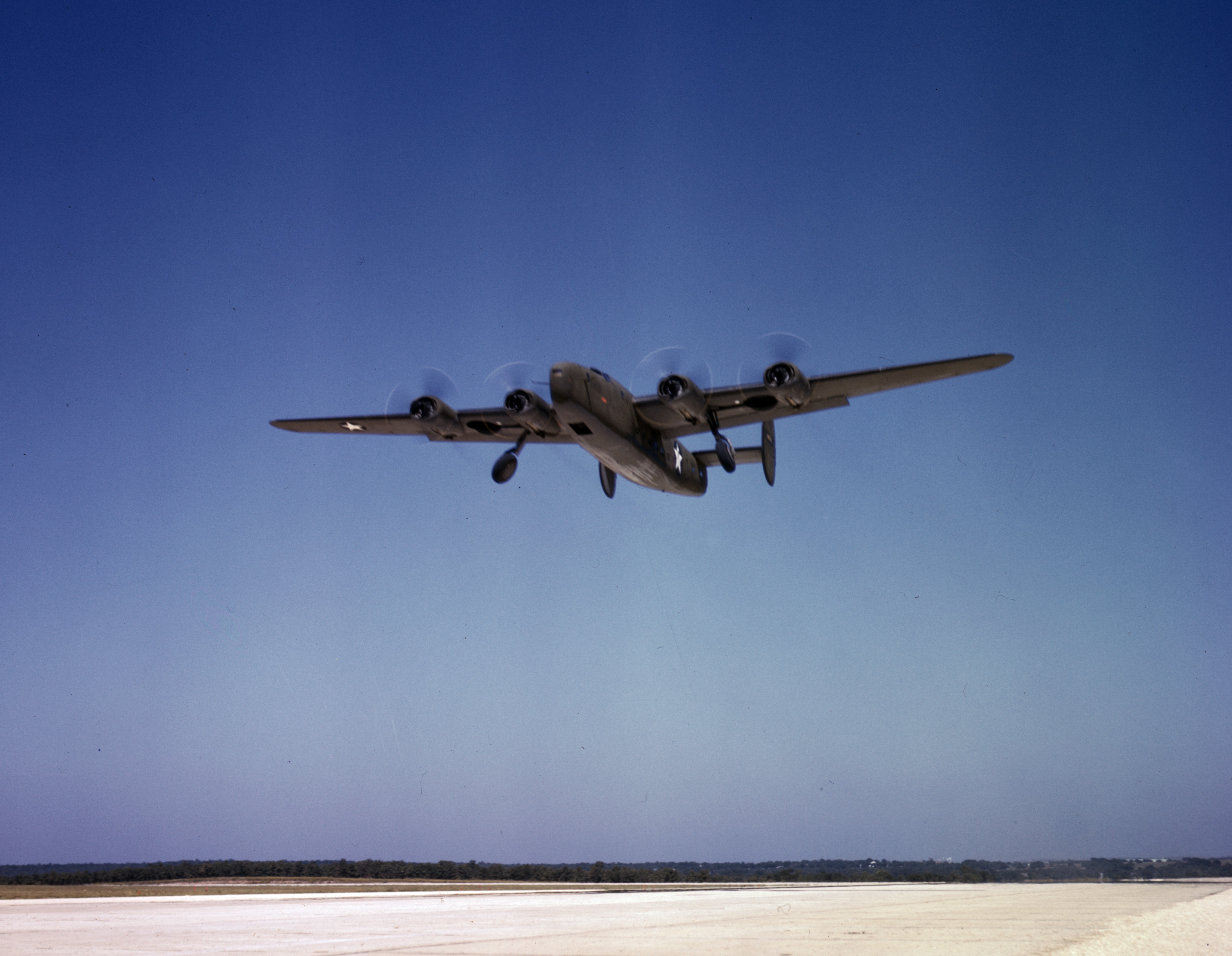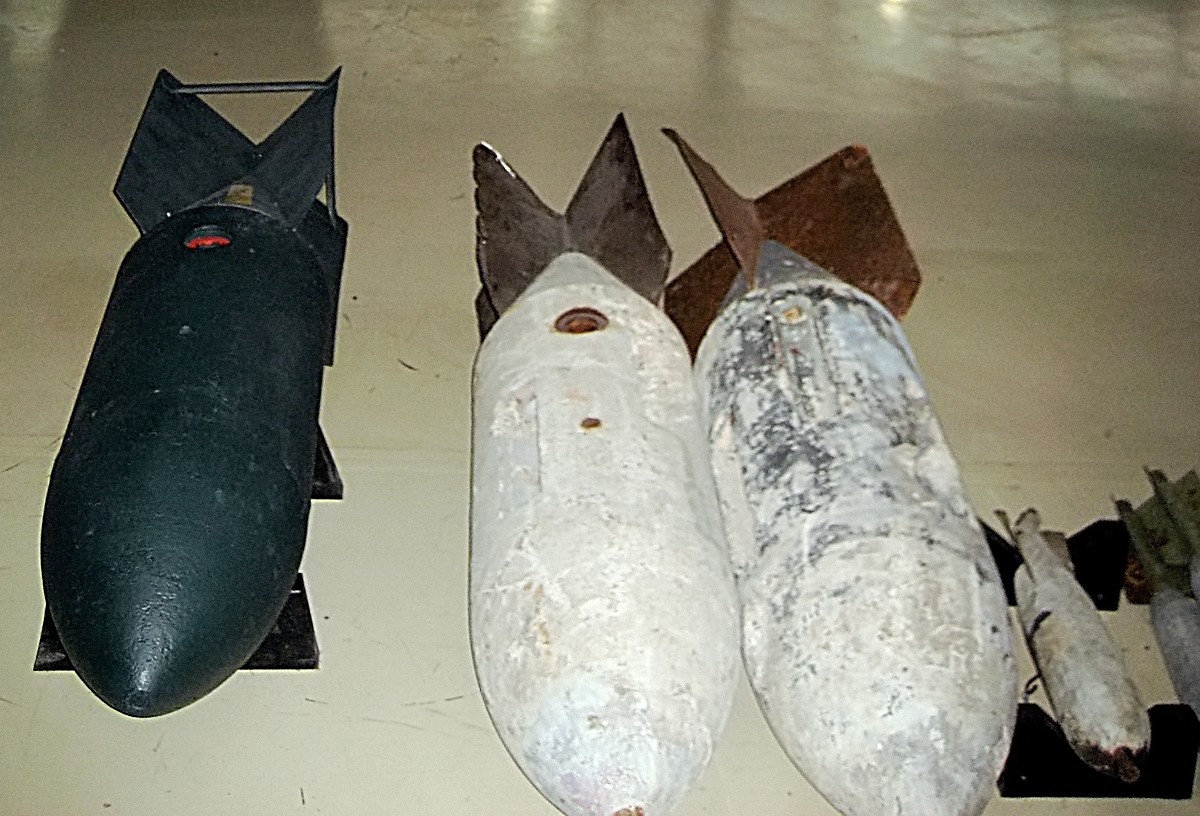|
LB-30
The Consolidated B-24 Liberator is an American heavy bomber, designed by Consolidated Aircraft of San Diego, California. It was known within the company as the Model 32, and some initial production aircraft were laid down as export models designated as various LB-30s, in the Land Bomber design category. At its inception, the B-24 was a modern design featuring a highly efficient shoulder-mounted, high aspect ratio Davis wing. The wing gave the Liberator a high cruise speed, long range and the ability to carry a heavy bomb load. Early RAF Liberators were the first aircraft to cross the Atlantic Ocean as a matter of routine. In comparison with its contemporaries, the B-24 was relatively difficult to fly and had poor low-speed performance; it also had a lower ceiling and was less robust than the Boeing B-17 Flying Fortress. While aircrews tended to prefer the B-17, General Staff favored the B-24 and procured it in huge numbers for a wide variety of roles. At approximately 18,500 ... [...More Info...] [...Related Items...] OR: [Wikipedia] [Google] [Baidu] |
Boeing B-17 Flying Fortress
The Boeing B-17 Flying Fortress is a four-engined heavy bomber developed in the 1930s for the United States Army Air Corps (USAAC). Relatively fast and high-flying for a bomber of its era, the B-17 was used primarily in the European Theater of Operations and dropped more bombs than any other aircraft during World War II. It is the third-most produced bomber of all time, behind the four-engined Consolidated B-24 Liberator and the multirole, twin-engined Junkers Ju 88. It was also employed as a transport, antisubmarine aircraft, drone controller, and search-and-rescue aircraft. In a USAAC competition, Boeing's prototype Model 299/XB-17 outperformed two other entries but crashed, losing the initial 200-bomber contract to the Douglas B-18 Bolo. Still, the Air Corps ordered 13 more B-17s for further evaluation, then introduced it into service in 1938. The B-17 evolved through numerous design advances but from its inception, the USAAC (later, the USAAF) promoted the aircraft a ... [...More Info...] [...Related Items...] OR: [Wikipedia] [Google] [Baidu] |
Consolidated Liberator I
Consolidated Liberator I was the service name of the first Consolidated B-24 Liberator four-engined bombers to see use with the Royal Air Force (RAF). A small number of B-24s were purchased for the RAF but assessment showed that they were not suitable for use over Europe. They were however suitable for long range maritime reconnaissance and were put into use with RAF Coastal Command. Service history In August 1939, the United States Army Air Corps (USAAC) ordered 38 examples of the Consolidated B-24A. From this order, 20 aircraft (serial numbers 40-2349 to 40-2368) were released for direct purchase by the RAF where it was given the service name Liberator B.Mk.I (from "Bomber Mark 1"). The twenty Liberator B.Mk.I were delivered to the RAF starting in mid 1941 and were given serial numbers ''AM910'' to ''AM929''. After a period of testing at the Aeroplane and Armament Experimental Establishment (A&AEE) at RAF Boscombe Down, England, it was found to be unsuitable for combat ov ... [...More Info...] [...Related Items...] OR: [Wikipedia] [Google] [Baidu] |
Consolidated C-87 Liberator Express
The Consolidated C-87 Liberator Express was a transport derivative of the B-24 Liberator heavy bomber built during World War II for the United States Army Air Forces. A total of 287 C-87s were officially delivered from Consolidated Aircraft plant in Fort Worth, Texas. The plant also developed and delivered a USAAF flight engineer trainer designated as the AT-22. The AAF C-87A was an executive transport version of the C-87. The United States Navy VIP transport designated as the RY. The last development was a Navy contracted, single tail version with an extended fuselage. Built in San Diego, its USN designation was RY-3 and the AAF had order the design as the C-87C. Those were cancelled and allotted to a Royal Air Force VIP transport designated as the Liberator C.IX In contrast, the C-109 Liberator was a fuel-transport converted from existing B-24 Bombers.https://web.archive.org/web/20090304014706/http://home.att.net/~jbaugher2/b24_27.html Consolidated C-109 Design and develo ... [...More Info...] [...Related Items...] OR: [Wikipedia] [Google] [Baidu] |
Consolidated Aircraft
The Consolidated Aircraft Corporation was founded in 1923 in aviation, 1923 by Reuben H. Fleet in Buffalo, New York, the result of the Gallaudet Aircraft Company's liquidation and Fleet's purchase of designs from the Dayton-Wright Company as the subsidiary was being closed by its parent corporation, General Motors.Yenne 2009, p. 15. Consolidated became famous, during the 1920s and 1930s, for its line of flying boats. The most successful of the Consolidated patrol boats was the PBY Catalina, which was produced throughout World War II and used extensively by the Allies. Equally famous was the B-24 Liberator, a heavy bomber which, like the Catalina, saw action in both the Asiatic-Pacific Theater, Pacific and European Theater of Operations, European theaters. In 1943 in aviation, 1943, Consolidated merged with Vultee Aircraft to form Consolidated-Vultee Aircraft, later known as Convair. History Consolidated Aircraft (and later Convair) had their headquarters in San Diego, California, ... [...More Info...] [...Related Items...] OR: [Wikipedia] [Google] [Baidu] |
Atlantic Ocean
The Atlantic Ocean is the second-largest of the world's five oceans, with an area of about . It covers approximately 20% of Earth's surface and about 29% of its water surface area. It is known to separate the " Old World" of Africa, Europe and Asia from the "New World" of the Americas in the European perception of the World. The Atlantic Ocean occupies an elongated, S-shaped basin extending longitudinally between Europe and Africa to the east, and North and South America to the west. As one component of the interconnected World Ocean, it is connected in the north to the Arctic Ocean, to the Pacific Ocean in the southwest, the Indian Ocean in the southeast, and the Southern Ocean in the south (other definitions describe the Atlantic as extending southward to Antarctica). The Atlantic Ocean is divided in two parts, by the Equatorial Counter Current, with the North(ern) Atlantic Ocean and the South(ern) Atlantic Ocean split at about 8°N. Scientific explorations of the A ... [...More Info...] [...Related Items...] OR: [Wikipedia] [Google] [Baidu] |
Davis Wing
The Davis wing is a World War II-era aircraft wing design that was used by Consolidated Aircraft on the Consolidated B-24 Liberator, as well as other models. The airfoil had a lower drag coefficient than most contemporary designs, which allowed higher speeds, and created significant lift at relatively low angles of attack. Its use in designs ended almost immediately following the end of World War II. Development and use Theory and testing In the summer of 1937 Reuben H. Fleet, president of Consolidated Aircraft met with David R. Davis. Davis was a freelance aeronautical engineer who was looking for development funds for his airfoil design, the "Fluid Foil". Davis had designed the profile "in reverse", starting with a basic low-drag teardrop shape and then modifying it to provide lift. In comparison with conventional designs, Davis's design was relatively thick, having a short chord while still being deep enough to allow a high aspect ratio. Davis claimed the new wing would off ... [...More Info...] [...Related Items...] OR: [Wikipedia] [Google] [Baidu] |
Range (aeronautics)
The maximal total range is the maximum distance an aircraft can fly between takeoff and landing. Powered aircraft range is limited by the aviation fuel energy storage capacity (chemical or electrical) considering both weight and volume limits. Unpowered aircraft range depends on factors such as cross-country speed and environmental conditions. The range can be seen as the cross-country ground speed multiplied by the maximum time in the air. The fuel time limit for powered aircraft is fixed by the available fuel (considering reserve fuel requirements) and rate of consumption. Some aircraft can gain energy while airborne through the environment (e.g. collecting solar energy or through rising air currents from mechanical or thermal lifting) or from in-flight refueling. These aircraft could theoretically have an infinite range. Ferry range means the maximum range that an aircraft engaged in ferry flying can achieve. This usually means maximum fuel load, optionally with extra fuel tan ... [...More Info...] [...Related Items...] OR: [Wikipedia] [Google] [Baidu] |
Aerial Bomb
An aerial bomb is a type of explosive or incendiary weapon intended to travel through the air on a predictable trajectory. Engineers usually develop such bombs to be dropped from an aircraft. The use of aerial bombs is termed aerial bombing. Bomb types Aerial bombs include a vast range and complexity of designs. These include unguided gravity bombs, guided bombs, bombs hand-tossed from a vehicle, bombs needing a large specially-built delivery-vehicle, bombs integrated with the vehicle itself (such as a glide bomb), instant-detonation bombs, or delay-action bombs. As with other types of explosive weapons, aerial bombs aim to kill and injure people or to destroy materiel through the projection of one or more of blast, fragmentation, radiation or fire outwards from the point of detonation. Early bombs The first bombs delivered to their targets by air were single bombs carried on unmanned hot air balloons, launched by the Austrians against Venice in 1849 during the First Ita ... [...More Info...] [...Related Items...] OR: [Wikipedia] [Google] [Baidu] |
WikiProject Aircraft
A WikiProject, or Wikiproject, is a Wikimedia movement affinity group for contributors with shared goals. WikiProjects are prevalent within the largest wiki, Wikipedia, and exist to varying degrees within sister projects such as Wiktionary, Wikiquote, Wikidata, and Wikisource. They also exist in different languages, and translation of articles is a form of their collaboration. During the COVID-19 pandemic, CBS News noted the role of Wikipedia's WikiProject Medicine in maintaining the accuracy of articles related to the disease. Another WikiProject that has drawn attention is WikiProject Women Scientists, which was profiled by '' Smithsonian'' for its efforts to improve coverage of women scientists which the profile noted had "helped increase the number of female scientists on Wikipedia from around 1,600 to over 5,000". On Wikipedia Some Wikipedia WikiProjects are substantial enough to engage in cooperative activities with outside organizations relevant to the field at issue. For e ... [...More Info...] [...Related Items...] OR: [Wikipedia] [Google] [Baidu] |
Ceiling (aeronautics)
With respect to aircraft performance, a ceiling is the maximum density altitude an aircraft can reach under a set of conditions, as determined by its flight envelope. Service ceiling Service ceiling is where the rate of climb drops below a prescribed value. The service ceiling is the maximum usable altitude of an aircraft. Specifically, it is the density altitude at which flying in a clean configuration, at the best rate of climb airspeed for that altitude and with all engines operating and producing maximum continuous power, will produce a given rate of climb. A typical value might be climb, or on the order of climb for jet aircraft. The one-engine inoperative (OEI) service ceiling of a twin-engine, fixed-wing aircraft is the density altitude at which flying in a clean configuration, at the best rate of climb airspeed for that altitude with one engine producing maximum continuous power and the other engine shut down and feathered, will produce a given rate of climb, usually ... [...More Info...] [...Related Items...] OR: [Wikipedia] [Google] [Baidu] |
San Diego
San Diego ( , ; ) is a city on the Pacific Ocean coast of Southern California located immediately adjacent to the Mexico–United States border. With a 2020 population of 1,386,932, it is the List of United States cities by population, eighth most populous city in the United States and the county seat, seat of San Diego County, the List of the most populous counties in the United States, fifth most populous county in the United States, with 3,338,330 estimated residents as of 2019. The city is known for its mild year-round climate, natural deep-water harbor, extensive beaches and parks, long association with the United States Navy, and recent emergence as a healthcare and biotechnology development center. San Diego is the List of municipalities in California, second largest city in the U.S. state, state of California, after Los Angeles. Historically home to the Kumeyaay people, San Diego is frequently referred to as the "Birthplace of California", as it was the first site vi ... [...More Info...] [...Related Items...] OR: [Wikipedia] [Google] [Baidu] |
Aircrew
Aircrew, also called flight crew, are personnel who operate an aircraft while in flight. The composition of a flight's crew depends on the type of aircraft, plus the flight's duration and purpose. Commercial aviation Flight deck positions In commercial aviation, the aircrew are called ''flight crew''. Some flight crew position names are derived from nautical terms and indicate a rank or command structure similar to that on ocean-going vessels, allowing for quick executive decision making during normal operations or emergency situations. Historical flightdeck positions include: * Captain, the pilot highest-ranking member or members of a flight crew. * First officer (FO, also called a co-pilot), another pilot who is normally seated to the right of the captain. (On helicopters, an FO is normally seated to the left of the captain, who occupies the right-hand seat).Smith, PatrickPatrick Smith's Ask The Pilot: When a Pilot Dies in Flight AskThePilot.com website, 2013, whic ... [...More Info...] [...Related Items...] OR: [Wikipedia] [Google] [Baidu] |




.jpg)




.jpg)
.jpg)